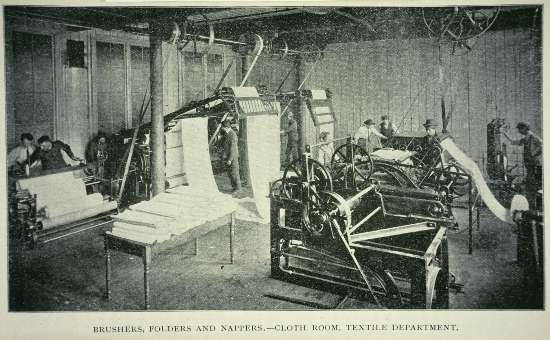 |
gtanno190203-56a
Location:
T171 .G42 G49x 1899-1903
Title: Date:
Brushes, folders and nappers--cloth room, Textile Department
1902?
Content:
Image of students working in the Textile Department.
History:
From Warren Drury's thesis: Architecturally, the Textile Building is a simple, inexpensive industrial
structure and in its textile manufacturing function is extremely successful. Modeled after small new
England Textile mills, the school commission reflected the Bostonian Lockwood Greene's experience in mill
design.
From the 1899-1903 Announcements: The department offers unexcelled advantages to the young man who intends
to enter the textile industry. We believe that the student, on graduating, should have a sound foundation
in engineering subjects as well as in the branches relating directly to the textile trade.
Besides the usual subjects given in the textile schools, such as carding, spinning, weaving, designing, and
dyeing, extensive courses in mathematics, English, chemistry, physics, mechanism, mechanics, drawing,
strength of materials, steam-engine, electrical work, mill construction, and shop work. Instruction in all
branches will be given by means of lectures, recitations, demonstrations, and practice on the splendid
equipment of the loom.
Department of Carding and Spinning: The study of the cotton fibre, including botanical classification of
cottons; location of the more important cotton-producing districts; primary species peculiar to each;
commercial names and comparative values; spinning properties and suitability for the different years;
commercial grading and classification; the chemical and physical properties of cotton.
Department of Weaving: This instruction begins with power loom practice in the production of duck,
sheeting, drills, etc. Later, classes are devoted to handloom weaving, the fabrics woven being mainly in
the nature of experimental work on textures, weaves and coloring. Final courses teach Jacquard weaving,
students making their own calculations, weaving and finishing and executing their own designs.
Department of Dyeing: This department occupies the east end of the basement in the A. French Textile
School. The laboratory and dye-house are well equipped with all the necessary apparatus, chemicals,
dyestuffs, etc, for instruction in the bleaching, scouring, and dyeing of textiles fabrics. A valuable
collection of over 3,000 specimens of dyewoods, extracts and colors comprise this collection. The
dye-house contains eight vats with water and steam fittings, a dyeing machine, steam chest, dye-ketltes,
measures, frames, etc.